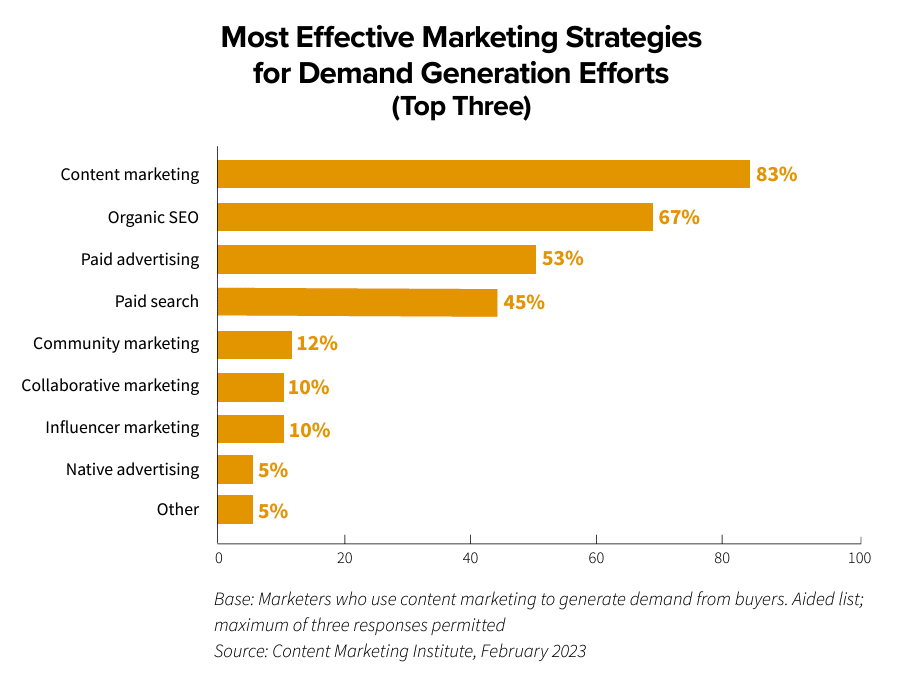Creating content for your company’s website or blog, but not sure if you are on the right track?
Many companies start out with the best intentions with their content marketing plans and end up disappointed when the content they create fails to hit the mark.
Lackluster results could be due to several factors, many of which can easily be avoided.
Why does some business-to-business (B2B) marketing content fail?
- Not relevant to target market
- Not distributed in the proper channels
- Doesn’t provide deep insights into customer needs
- Promotional instead of educational
- Confusing to follow, or hard to find
- Inconsistent publishing schedules
- Lack of strategy
- Unrealistic expectations
Or, the proverbial nail in the coffin? Your content looks and reads just like everybody else’s.
Don’t fret. With a little planning and organization, you can avoid these pitfalls and create content your customers want to read and consume. Content like blogs, case studies, industry reports, engaging social posts, whitepapers and webinars.
Here are some simple tips to create effective content for your B2B customers.
How to Write Effective B2B Content: 23 Marketing Insider Tips
Rather than creating content that “goes viral,” B2B companies find success when they focus on creating content that helps them stand out from the competition. By providing quality content that offers value to your buyers, you can establish your company as a trusted and reliable resource.
83% of marketers say content marketing is the most effective marketing strategy for demand generation efforts across all parts of the buyer journey.
Content Marketing Institute

Whether you have a marketing department to lean on or it’s just you, follow these tips to create content that answers the call.
1. Be helpful first. Sell second.
Content marketing does best when it helps the customer make informed decisions about their products, applications and purchasing needs. Refrain from the hard sell. Demonstrate you are a trusted partner there for the long term, instead of just a product seller.


2. Know your audience.
It can be tempting to write the kind of content you think your customer wants to see. A better idea is to ask your customers directly. How can you help make their buying experience better? How do they currently seek information related to their purchases? What are their biggest challenges? Customer surveys, interviews and original research are great ways to capture this data. Research their buying behaviors, demographics and how to improve their bottom line. Then, create content that speaks to those needs.
Learn how to develop B2B audience personas for your content strategy. >>
3. Start with a content strategy.
Many a great marketer has made the same crippling mistake with content creation: They get excited and jump in without a clear plan and end up with disconnected content that confuses the reader. A clearly defined content strategy will align actions with intent, manage expectations and avoid wasting time on ineffective marketing, while improving the performance of the content.


4. Spend time on SEO.
Even if you are unfamiliar with the ins and outs of content marketing, you have likely heard a thing or two about the evolution of search engines. Search engines, like Google, are smart and play a major role in how well a company’s blog or website performs. Without effective optimization, your great content runs the risk of never being found online. Consider working with an SEO specialist to make sure your content is optimized for success.
5. Write content for humans not robots.
Whether you are a seasoned marketer or new to the scene, you know how important it is to write blogs so search engines can find you. That’s only half the story. Search engines are constantly evolving and breaking their code is near impossible. Of course, use SEO best practices, but always write with a human being in mind. That means: Be clear, engaging and informative.


6. Don’t be afraid of long-form content.
A common misconception B2B companies have is that customers won’t take the time to read long-form content. That may be true if an article is one huge wall of text. But don’t assume the information isn’t valuable or appreciated. Long-form content can not only address potential customer questions, it can also help your page’s authority and rank in search. It’s best to diversify the type and length of content (blog posts, videos, social media, case studies, newsletters) to meet buyers where and how they like to spend time.
Simple fix: Break up text with sub-headers, bullets, visuals and graphics to draw the reader’s eye down the page.
7. Take a salesperson “ride-a-long.”
Sales and marketing must coexist peacefully. To be effective, both departments must work together to identify new opportunities and phase out stale tactics to find more consistent revenue streams. As a marketer and writer, the first person I want to talk with when creating content is the salesperson. They know your customers’ needs better than anyone and they speak the language. Their input will make your content strategy more effective.


8. Write what you know.
Turn to the experts on your team and in your network. Your employees are a great resource for developing topics your customers care about. Have a brainstorming session to uncover potential topics that could be helpful to your customers. Other places to find inspiration for creating customer-focused content are social media platforms and industry forums. Most importantly, talk to your customers!
Pro Tip: Don’t be afraid to ask questions and interview subject matter experts outside your wheelhouse to get greater insight.
Get our tips for making the most of subject matter expert interviews. >>
9. Make your content easy to share.
In addition to creating content that is useful and customer-focused, appeal to your readers’ sensibilities. Find out what’s trending in their worlds and create content that speaks to those issues. Include videos and imagery to catch their eye. And don’t forget those social sharing buttons that make it convenient for them to share your content with colleagues, friends and business partners.


10. Partner with industry publications.
Find out where your customers go for their information and then build relationships with editors at those industry publications. These can include niche forums, trade magazines, academic journals or newspapers that are of particular interest to your targeted industry or profession. Build a solid reputation for submitting informative and accurate content, you’ll have a friend for life at that publication.
Learn how to get your article published in a trade magazine. >>
11. Use AI responsibly.
Artificial intelligence (AI) may help the speed and frequency of your content creation. Yet, while content experts agree that AI can be a powerful tool for improving the quality of content writing, they also caution against relying too heavily on this technology. Ultimately, it’s up to human writers to ensure their work is engaging, accurate and relevant to their target audiences. We recommend using AI to brainstorm content ideas and outline content briefs but be sure to apply a close human eye to catch any inaccuracies.


12. Use a clear and compelling CTA.
After reading your content, do you want the reader to take a certain action such as subscribe to your blog, visit your eCommerce site or call a representative for more information? Then, tell them with a call-to-action (CTA). Be clear and direct about the benefits they will receive if they take that action. For example: Subscribe Now or Browse Products or Schedule Consultation.
Pro Tip: Choose an attention-grabbing color font as your CTA.
13. Use connections for support.
For instance, if you’re an industrial company, your suppliers have spent years developing resources that help them highlight and sell their products. Use those resources to your advantage. Reach out and ask how you can better align your marketing initiatives with theirs. Often, they can offer cooperative marketing dollars to help fund some aspects of marketing. Supply partners also have a wealth of knowledge and you’ll often find sales reps or product managers are more than happy to spend time explaining a product or application.


14. Spend time on website pages.
In this digital age, people are spending much of their time researching solutions online before they ever talk to a sales representative or place an order. Spend time updating the copy (sales-focused content) on key webpages including your Home Page, About Us, Services and Product Landing Pages. Be clear and direct about why potential customers should choose you over the competition. And make sure your website is mobile phone friendly!
15. Share customer case studies.
Case studies are success stories that demonstrate the ways your products and services have helped your customers. By showing real-life examples of increased productivity, safety, cost and time savings or inventory reductions as a result of working with you, you can convert prospects into new customers. If you have good customer relationships, you’ll be surprised to learn how many of those customers are happy to share their experiences and help you get the word out.
Learn how to write B2B case studies that convert prospects. >>


16. Choose quality over quantity.
It takes time to produce high-quality content, and it often involves research, subject matter interviews and several revisions before the content can be considered final. It can be tempting to build a resource library quickly, but lesser-quality pieces of content will not build trust with your audience and ultimately just take up space. Take your time and place value on the content you create. And don’t forget to repurpose existing content to use for social posts and infographics, or design printed collateral like leave behinds for your sales team.
17. Constantly improve your content over time.
Content on your blog or website should always be a work in progress. Take opportunities to go back and revisit pages that may not be performing well and make small adjustments such as headlines, additional testimonials, product features or new information you have gathered. You will learn more about your customers’ online needs over time. Make sure your content reflects what you learn.


18. Don’t give up so quick.
This is where the rubber meets the road, and your dedication can make or break a successful content strategy. Content marketing is different than sales in that it takes time to see the fruits of your labor. While sales are often driven by frequent touchpoints, ads and promotions, content is a long-term investment that builds credibility over time. It is not a magic bean that immediately produces results, yet it is a necessary component of your brand identity. Give it time, track your results and make small adjustments until you get it right.
Learn more about measuring content ROI in B2B (hint: It’s complicated). >>
19. Social engagement is everything.
For content to be successful, every member of your team must be invested. That includes sharing insightful blog posts with friends and colleagues, commenting on social media and contributing to subject matter interviews. The more they are excited about promoting the company they work for, the more inspired potential customers will be to pick up the phone. Just remember to follow the individual best practices for each social platform.


20. Align sales and marketing departments.
It’s no secret that sales and marketing have a history of butting heads, even when their goals are similar. And it makes sense that there is a disconnect. Every minute a sales rep isn’t on a call or reaching out to a customer, they lose revenue. On the flip side, marketers are busy planning for the long game. The best solution for both departments is to become familiar with the goals and challenges they each face. Then, collaborate regularly to create both short and long-term strategies.
21. Don’t forget your Google Business Profile.
Do you have a Google Business Profile (formerly known as a Google My Business listing)? Is it increasing exposure to your business and driving engagement? Since so many people are researching online prior to purchasing, take advantage of Google’s simple, but effective tool to reach your buyers. Claim your Google Business Profile today and start linking to it in emails, newsletters and your website.


22. Encourage customer feedback.
People respond better when they are involved in the conversation, online and in real-life. Encourage participation and feedback through interactive surveys or open the comment sections and actively respond to questions and insights. This feedback can be a valuable source of common questions or concerns your customers are facing.
23. Spend time on industry outreach.
Backlinks are created when highly ranked sites that are considered authorities in your niche link to a page on your website. Search engines like Google value quality backlinks and use them as part of their ranking criteria. Here’s an example outreach email you can use to help increase your backlinks:

[Greeting]
I was looking for some content to read about [Topic] this morning and I came across your intriguing post: [Article Title]. I really enjoyed your article but couldn’t help but notice that you mentioned [Old Resource]. You may not know, but we have loads of updated product information and use cases you could use as a resource.
Here’s where that link is located: [Screenshot]
Our company also published a piece about [Topic] that you may find interesting. If you have any questions, please reach out!
[Closing]
Bonus Tip: Don’t Confuse B2B Marketing with B2C
A common mistake many new marketers, decision-makers and writers make when creating a content marketing plan is confusing B2B and business-to-consumer (B2C) marketing.
You can maximize your content efforts by understanding exactly how they are different.
Compared to B2B buyers, B2C customers are more subject to emotionally-driven purchases. That’s why marketing tactics that are flashy, funny or nostalgic tend to perform well. B2C buyers also hold the purse strings and don’t usually need to seek approval before they click the ‘Buy Now’ button.
B2B customers are unique in that they are making necessary and routine purchases for their company. They’re buying items such as MRO supplies, cutting tools, new software or safety equipment to name a few. As one would imagine, these purchases don’t invoke the same excitement the B2C buyer may experience when buying a brand-new golf club or the latest smart phone. Rather, the purchase is often guided by necessity, budget and quality over wants and desires.
Additionally, depending on the company size and structure, that B2B purchase may require the approval of multiple stakeholders and go before the purchasing department or other key players. Price, availability, product knowledge and support are among the top reasons why B2B buyers choose one company over another.
If you love this list of 23 tips, make sure to grab the PDF version!
Want to learn more about creating compelling content for the B2B buyer? There’s a wealth of knowledge out there on creating effective B2B content that drives engagement. We know, we wrote quite a few of them.
Check out our resource library. >>
If you need help planning and producing effective content for your marketing funnel, reach out to us at info@3aspensmedia.com. Our content services range from messaging and strategy to design and distribution.




